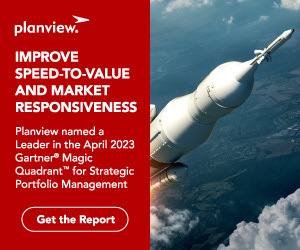
In our first two posts in this blog series, we provided examples of how organizations are using dynamic planning and rapid reprioritization to pivot quickly in response to disruptive change and new opportunities. We also outlined how EPMOs and finance leaders should work together with the C-suite to make the best decisions possible in both the short and long terms:
Part 1: Dynamic Planning and Rapid Reprioritization: Resilience Amid Disruption
Part 2: Dynamic Planning: Refocus, Reprioritize, and Reallocate Rapidly
What’s the next level of dynamic planning? It’s operationalizing the new plans to ensure everyone keeps executing on strategy. But how do you perform quick reprioritization, shift resources, reallocate budgets, and realign teams – especially when you’ve got employees scattered across time zones, cultures, work methodologies, and now mostly home offices – or dining room tables?
PMOs are in a position to smoothly facilitate all this. They can ensure that people, money, and technologies are focused on the right work that will deliver the strategy. Here are some of the ways savvy PMOs are doing this.
Staying on Strategy Amid Disruption
PMOs have a Rosetta Stone of sorts: Strategic roadmaps that help them continuously translate strategy to delivery on an organization-wide, cross-functional scale. As plans change the PMO determines how best to adjust or shift resources, budgets, and outcomes (products, technologies, services, etc.) to achieve the strategic objectives.
They can prioritize and rank projects based on their alignment with corporate strategies and financials. PMOs can then create actionable plans at project and program levels, which are key to keeping everyone aligned and working on strategy at all times.
Savvy PMOs reassess and adjust plans as needed via continuous planning. They have real-time insight into variables such as project financials, resources, daily execution changes, and performance, all of which tie back into the strategic and portfolio plans.
As strategic plans and priorities are revised and new information comes in from across the enterprise, PMOs can rapidly execute reprioritization, shift projects out or in, or even place them on hold. The entire organization is then able to align in concert.
Ensuring Work Delivery
It’s challenging in the best of times to ensure that work is being done on strategy. Today, when most teams are working virtually, aligning to strategy and reprioritization are even more difficult. Distributed teams are nothing new though, and many organizations are successfully keeping their teams engaged, motivated, and performing at a high level with the right work visualization tools.
One way PMOs ensure timely, quality, on-strategy delivery is by supporting all the different ways teams work today, such as traditional projects, hybrid or iterative, Lean, Agile, and collaborative. Rather than micromanaging, these PMOs focus on helping their teams deliver the highest value work using a method best suited for the team.
For example, Agile teams are free to use their own tools, methodologies, and processes as well as prioritize their tasks and work. PMOs track team progress and ensure that their work is supporting strategic objectives. When multiple teams or team of teams have conflicts over resources, budgets, or the actual work, the PMO can resolve these and keep everyone on track.
Staying on strategy requires visibility into status, trends, and interdependencies across the program. Teams need shared, digital workspaces that enable them to collaborate and get things done. Data from these workspaces and other mixed work execution and applications feed critical information back into the centralized PPM tool and roll up to the portfolio. With this data at their fingertips, PMOs can visualize, share, and investigate performance to identify issues, manage against KPIs, and adjust plans as needed.
Managing Resources Effectively
Savvy PMOs have visibility into in-flight work as well as future demand. With this information, they can efficiently identify people and teams for the right projects at the right time. They’re able to proactively identify capacity constraints by role, location, and other factors, such as reduced individual capacity due to working at home, temporary leave, or unfortunate reductions in the workforce.
As plans and budgets shift, PMOs use reprioritization to rebalance, re-prioritize, and reschedule resource capacity across all projects and work. Their decisions are informed by creating and comparing scenarios to evaluate different staffing options. They can see how various scenarios impact different project portfolios.
Tracking Planned and Actual Financials
Reprioritization provides the ability to quickly reallocate budgets which is critical during times of rapid change. Annual plans and budgets limit agility – with change happening soon after they are approved. Many organizations are shifting to incremental funding, which enables quick reallocation as priorities shift, projects are placed on hold or canceled, or new growth opportunities arise.
At the least, it’s critical to manage costs against budget. PMOs can provide actuals compared to planned for portfolio and project progress, role and resource usage, and costs. This enables them to rearrange work, promote on-time delivery, and manage financials.
Visualizing Impacts of Reprioritization
The right visibility and reporting is key to delivering on strategy. Savvy PMOs have real-time visibility into performance spanning strategy, programs, projects, and resources, enabling them to make necessary decisions and adjustments swiftly.
Executives and other stakeholders across the enterprise can have access to this information to help make these decisions and keep plans on track. Real-time visibility enables them to work with PMOs to answer questions such as:
- Are we working on the right projects to support our business goals and objectives?
- Do we have enough people with the right skills available to complete the work?
- Are we within budget and getting the expected return on investment?
- Do we have the right mix of projects and products to meet our strategic initiatives?
Savvy PMOs work to identify the most important metrics for stakeholders, then build reports and dashboards to visualize that information. Executives must quickly see high-level status and performance of KPIs and metrics for reprioritization can happen at any time.
Be the Change Agent
Disruptive change can be hard on everyone. PMO leaders are well positioned to help the organization quickly repivot and focus on what delivers the most value at any time, including during times of disruption. It’s not just about reorienting resources, it’s about strengthening the organization’s competitive position in the long run.
Planview is here to help you run this gauntlet with agility. Our full spectrum of Portfolio Management and Work Management solutions help organizations accelerate on-strategy delivery and empower teams to deliver their best work. For current PPM Pro customers, see my six-part video series with practical tips for “Responding Quickly in Times of Change.”
For more information on PPM Pro and to download a demo, visit https://www.planview.com/products-solutions/products/ppm-pro/






